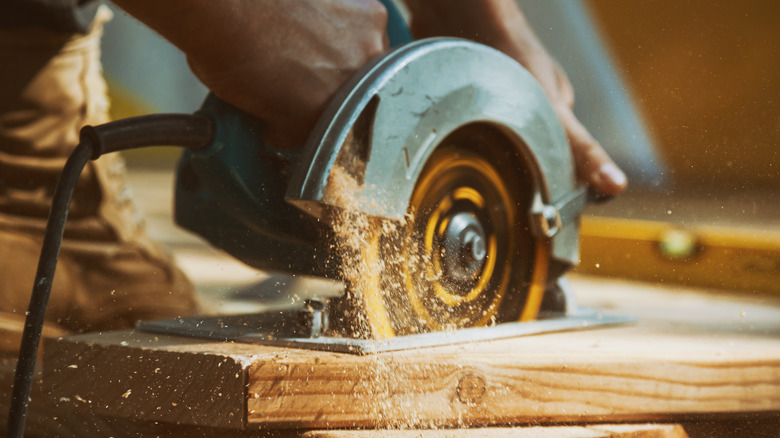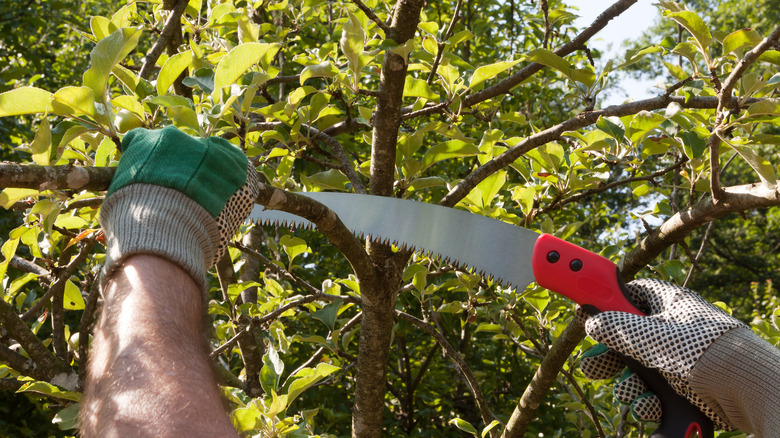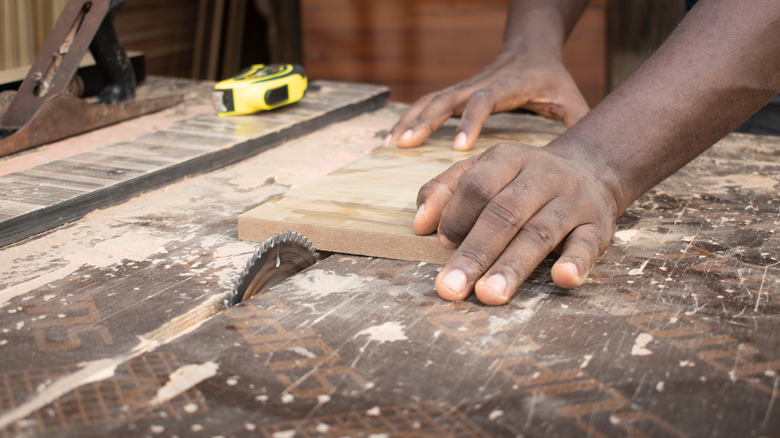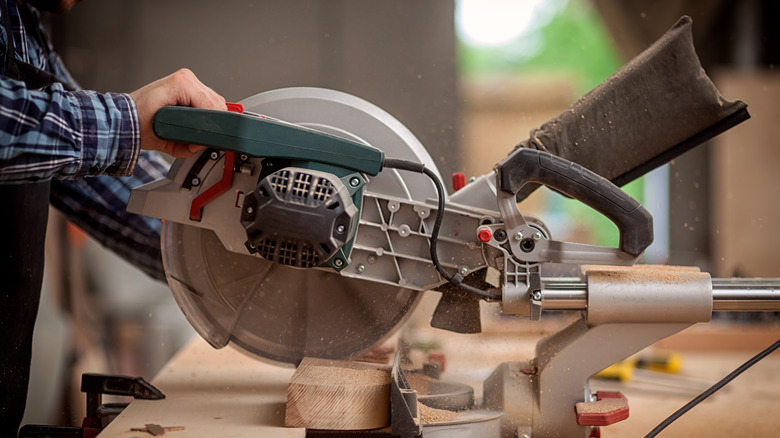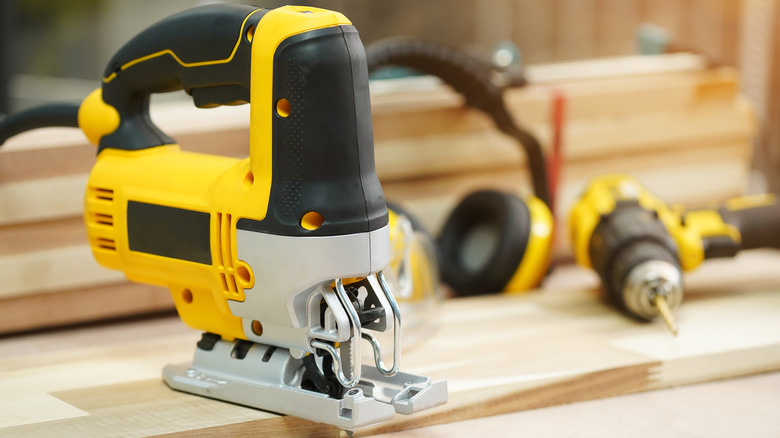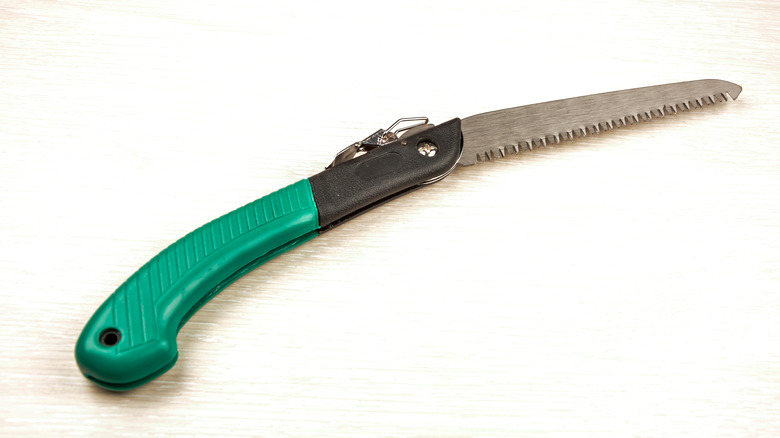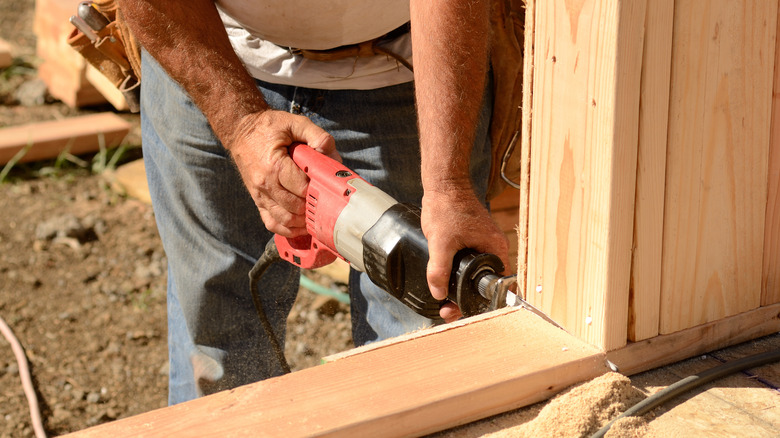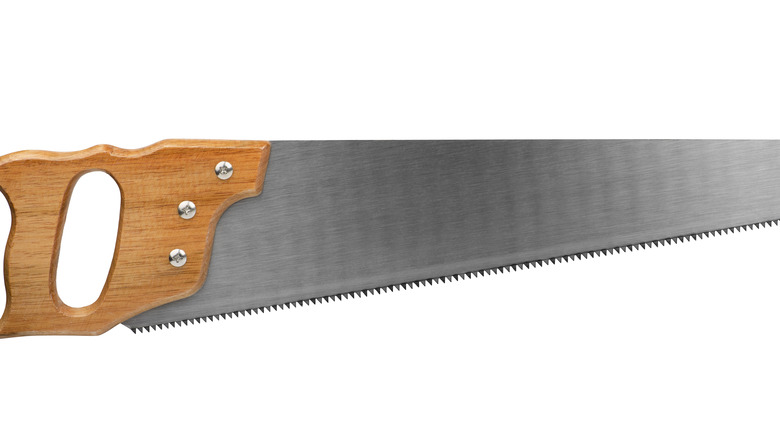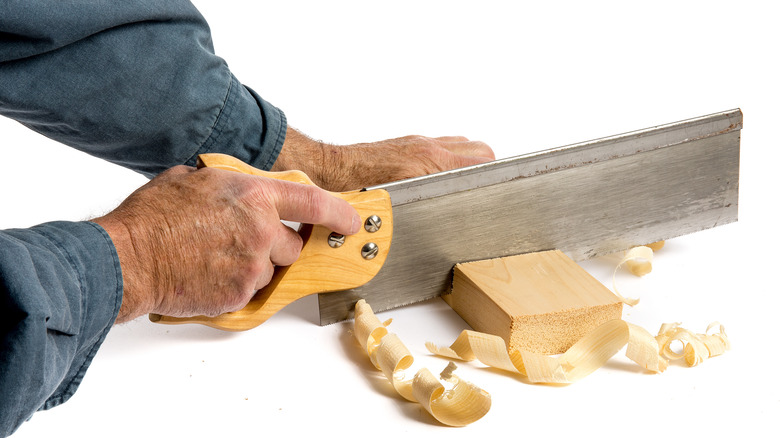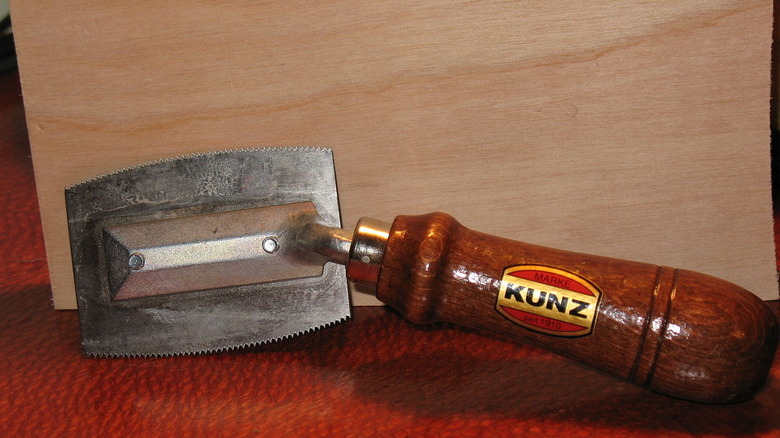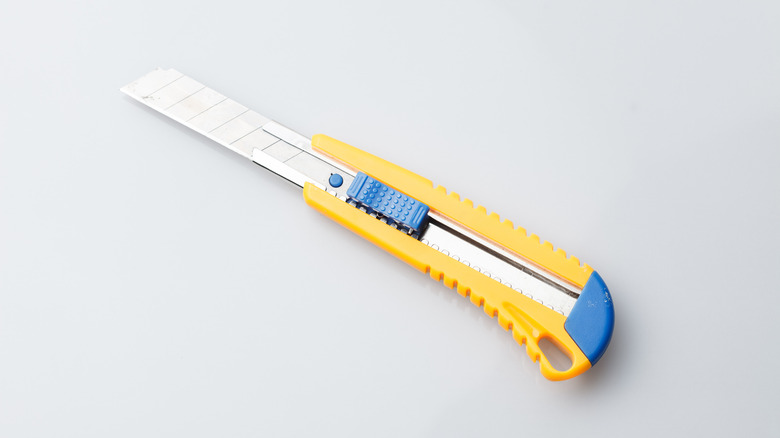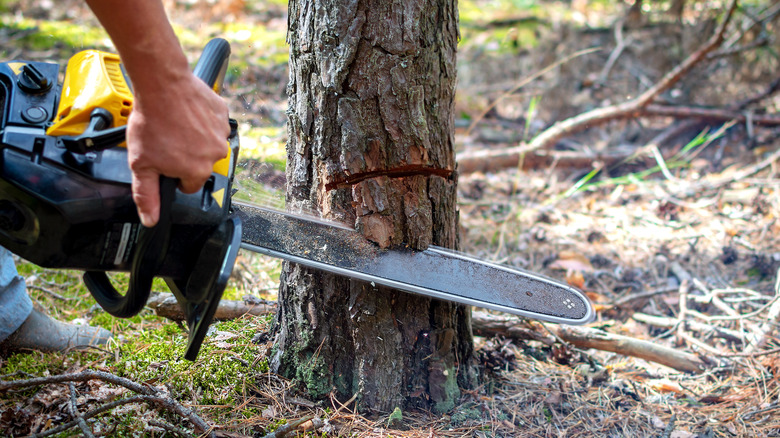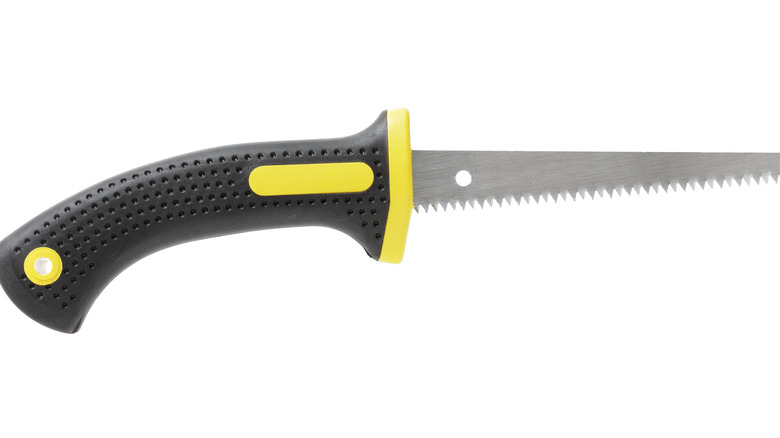15 Types Of Saws That Can Cut Through Any Wood
Since we have already introduced you to the types of wood for building, it is only fitting that we discuss the best types of saws that can cut through wood. Whether you want to build a shed, prune tree branches, or create intricate wood pieces, you will need a great set of saws to help you bring your vision to life.
But where to start? As our friends at Bob Vila explain, the blades of saws are rated by teeth per inch (TPI), therefore the answer lies in the teeth. The meaning and general rule here is that saws that possess low TPI ratings, typically ranging from 2 to 32, make cuts faster but on the more ragged side. Conversely, saws with TPI ratings on the top end will make cuts on the more even and smooth side because they do not work as quickly as their counterparts. Familiarizing yourself with the following woodcutting saws will help you select the right saw for your project.
1. Circular saw
A circular saw is a power-saw that makes precise, straight-line cuts. It uses a rapidly rotating toothed disc to cut through lumber. Per HowStuffWorks, this popular woodcutting tool features a handle with an on/off trigger switch, safety guards to prevent contact with the spinning blade, and an arbor nut to hold the circular blade firmly. It is also multifunctional, offering different blades for cutting other materials apart from wood, such as plastic and metal.
Circular saws allow height, depth, and bevel adjustments, as well as angled cuts up to 45 degrees. Pro tip: Always wear eye protection when using this power saw.
2. Universal hand saw
Every homeowner or woodworker needs a universal hand saw, or simply, a hand saw as it is known in most circles. Not only is it one of the most basic types of saws that cut through wood, but also a versatile tool that can be used around the house and garden for framing and repair purposes.
As ManoMano states, universal hand saws offer different-sized teeth to support various cutting projects. In essence, the bigger the teeth, the quicker you will cut through wood, though the edge will be rough. Small-toothed hand saws, in contrast, produce cleaner cuts with more precision, except it takes twice as long to get the job done.
3. Pruning saw
Pruning saws have the same features as hand saws for cutting lumber, except they are used to trim live tree branches and large, dense shrubs. As Gardening Know How explains, manufacturers typically fashion the blades of these saws from tempered steel and equip them with more teeth per inch than similar-sized saws. This design allows pruning saws to cut on both the push and pull stroke, making them more efficient than regular saws. There are four types of pruning saws:
- Pole pruning saws for cutting higher branches
- Handheld pruning saws for trimming houseplants
- Straight blade pruning saws for cutting the thinnest branches
- Curved blade pruning saw for cutting thick branches
4. Table saw
A table saw is one of the types of saws that cut through wood that consists of a centered, upside-down circular saw blade driven by an electric motor. It is a staple in carpentry, allowing woodworkers to repeatedly make precise cuts until the desired wood pieces are achieved.
Table saws can cut large sections of lumber and make accurate cuts better than handheld or portable powered saws, per Saws Reviewed. It can be a worthwhile investment as it provides users with large amounts of convenience and consistency. The parts of a table saw include a 10- to 12-inch blade, blade plate and cover, anti-kickback claws, rip fence, miter gauge, and bevel angle gauge.
5. Miter saw
You can use a miter saw to make angled cuts between 45 to 90 degrees for crown moldings or create a finished look on a piece of lumber. It is also perfect for cutting large widths, trimming work, as well as making rafters, straight crosscuts, door frames, window casings, and picture frames. When equipped with the right blade, this tool becomes even more versatile.
To use a miter saw, according to Better Home & Gardens, mark your wood piece, position the clamp at least 6 inches from the blade, tighten until secure, make miter and bevel adjustments as needed, and saw from front to back to avert kickbacks.
6. Jigsaw
We cannot discuss the types of saws that cut through wood without mentioning jigsaws. These woodworking tools are either used to create round, intricate cuts, or irregular stenciled designs in wood. Apart from curved cuts, they can make straight cuts, bevel cuts, and plunge cuts. Jigsaws have a lightweight and compact design and consist of a narrow, reciprocating blade that connects to the tool's frame via a front-sitting spring-loaded clamp.
Even though jigsaws can cut through several materials — for example, ceramic tiles, sheet metal, and plastic – Wonkee Donkee Tools does not recommend using them on stone and concrete, since their motors are not powerful enough to support harder materials.
7. Folding saw
House Grail considers folding saws a space-saving alternative for pruning saws. Due to their lightweight, compact design, they come in handy during outdoor activities like hiking, camping, or backpacking. Since they typically feature a sheath, non-slip grip, and small, evenly-spaced razor teeth, you can use them in your house and garden. Per our source, there are two primary styles of folding saws:
- Pruning style: Consists of a slightly curved blade that folds into the handle. Can be holstered or slipped into small storage spaces.
- Folding bow style: Triangle-shaped, offering a straight, steel blade with jagged teeth for cutting through thicker wood and other materials.
8. Reciprocating saw
Reciprocating saws are not for precise woodworking cuts, but they make perfect plunge cuts. If you need one of the best types of saws that can cut through wood quickly for, say, renovation and demolition purposes, grab one of these bad guys. They possess a thin metal blade with long teeth that cuts in a reciprocating motion. They also feature an adjustable shoe that prolongs the blade's durability and offers control when cutting curved materials or wood with one hand.
Per the Thomas Brand Center, reciprocating saws are quite similar to chainsaws and though electrical, they can be battery-powered for increased comfort and versatility.
9. Crosscut saw
Crosscut saws, also known as felling saws or bucking saws, join the list of popular woodcutting hand saws. These saws, compared to other traditional handsaws, have thick blades with large beveled teeth that make the best cuts on rough wooden surfaces.
According to Tools Haven, there are two types of crosscut saws: two-man crosscut saws and one-man crosscut saws. The former consists of a handle on each end for two people to simultaneously cut across rough wood or thick timber. The latter, on the other hand, is the perfect saw for carpentry, rough-cutting lumber, and trimming limbs or branches.
10. Backsaw
You will need the relatively thin blades and small, finely set teeth of the back saw if your woodworking project requires accurate cuts, or if you need to make joints and grooves in the wood. According to HowStuffWorks, a standard backsaw has a plastic or hardwood handle and an 8- to 4-inch long rectangular blade comprising 11 to 20 teeth per inch.
There is also a heavy strip of metal, typically brass or steel, along the top edge of the blade to keep the blade straight when in use. We consider this hand saw one of the types of saws that can cut through wood effortlessly.
11. Hole saw
A hole saw is for cutting round holes with a much larger diameter in wood and other materials, including concrete, metal, plastic, and stainless steel. Artisans in the carpentry, plumbing, and electrical trade value this power tool because, unlike standard drill bits, it creates perfect holes of varying sizes without cutting up the core material. This is why they are used to drill big, deep holes and enlarge existing ones, Toolstop explains.
Hole saws can be hazardous, so be sure to clamp all small pieces or loose components in your workpiece to keep them from moving. Pro tip: Maintain a firm, two-handed grip when working to prevent an accident.
12. Veneer saw
As its name implies, a veneer saw is used to cut thin veneers, which are decorative sheets of wood for covering coarser wood pieces such as furniture, doors, and cabinets to produce a smooth finishing effect. Since the standard thickness of veneers is between 0.4 to 0.6 millimeters, it is imperative to use a veneer saw to attain the right sizes. Per Fine Tools, these hand saws have reversible, double-edged blades with small teeth that must be kept free of debris to maintain precision. Veneer saws, when used alongside a straight edge, can cut square-edged wood pieces that are perfect veneer matching, making them one of the best types of saws that can cut through wood.
13. Razor saw
As House Grail states, razor saws are small back backsaws featuring finely pitched crosscut teeth, usually with no set. They are employed when making clean, precise cuts in very soft wood like balsa, which other saws tend to destroy or tear-out. When you purchase a razor blade, you will quickly notice that the teeth are so small, making them impractical to re-sharpen. For this reason, these hand saws feature disposable blades, allowing you to make as many clean cuts as you please. Unlike other members of the back saw family, razor saws can cut soft metals, as well as plastics.
14. Chainsaw
This is, perhaps, one of the most popular types of saws that can cut through wood. According to Consumer Reports, a chainsaw is an indispensable power tool that uses a sharpened metal chain link attached to a guide bar to cut wood and trees of varying thickness. It is quite a versatile tool, used for felling, pruning, limbing, bucking, harvesting firewood, and even cutting firebreaks for wildfire suppression.
Property owners, for the most part, prefer electric and battery-powered models to their gas-powered counterparts since they tend to vibrate less and effectively reduce fatigue on time-consuming jobs. No matter your preference, be sure to adhere to all safety precautions when using this powerful tool.
15. Keyhole saw
If you want to cut holes, create intricate shapes, follow the right curves, make internal cuts, or reach inaccessible places on your workpiece, this is the handsaw to grab. Per Top Woodworking Advice, keyhole saws cut on the pull stroke, leaving a narrower cut and effectively producing cleaner results.
This thin-blade saw has a dagger-like appearance and consists of a fixed or retractable blade that ranges from 5 to 15 inches in length. Keyhole saws, also known as pad saws, drywall saws, or jab saws, work well with softer woods, drywall, carpet, rubber, plastics, and other firm but thin materials.

